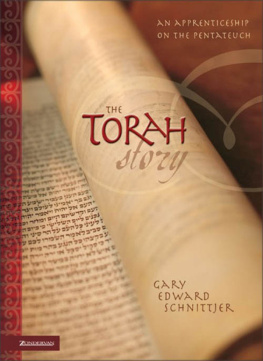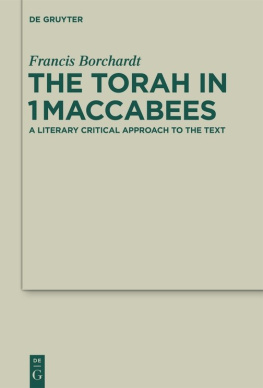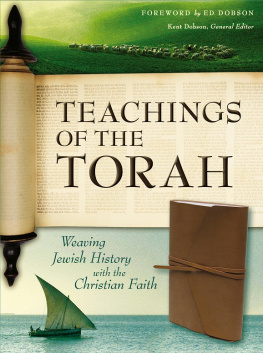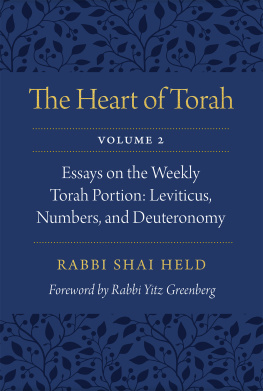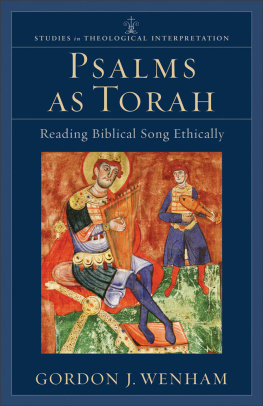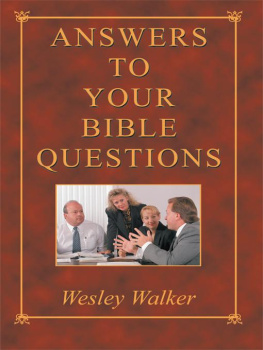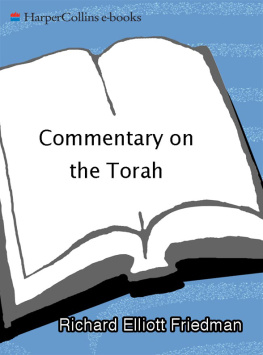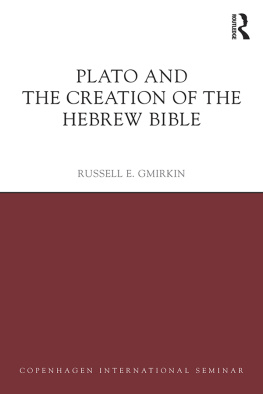All rights reserved under International and Pan-American Copyright Conventions. By payment of the required fees, you have been granted the non-exclusive, non-transferable right to access and read the text of this e-book on-screen. No part of this text may be reproduced, transmitted, downloaded, decompiled, reverse engineered, or stored in or introduced into any information storage and retrieval system, in any form or by any means, whether electronic or mechanical, now known or hereinafter invented, without the express written permission of Zondervan.
Schnittjer, Gary Edward.
The Torah story : an apprenticeship on the Pentateuch / Gary Edward Schnittjer.
p. cm.
Includes bibliographical references and indexes.
1. Bible. O.T. PentateuchCriticism, interpretation, etc. I. Title.
All maps by Mosaic Graphics. Copyright 2006 by Zondervan.
The website addresses recommended throughout this book are offered as a resource to you. These websites are not intended in any way to be or imply an endorsement on the part of Zondervan, nor do we vouch for their content for the life of this book.
CHAPTER ONE
An Apprenticeship on the Torah
GETTING STARTED
Focus Question
How should one read the Torah story?
Look for These Terms
- extended echo effect
- mirror imaging
- narrative
- Torah
Advanced Terms
- intertextuality
- irreducibility of narrative
- narralogic
I NTRODUCING T HIS B OOK
T his book is designed to assist with studying the first five books of the BibleGenesis, Exodus, Leviticus, Numbers, and Deuteronomy, also known as the Torah, the Five Books of Moses, or the Pentateuch (this word based on Greek means five books). For some readers this book will be part of an apprenticeship in the form of a course on the Pentateuch, or on the Old Testament with attention to the first five books of the Bible. The book can be used, however, by any person who wishes to learn the Torah or at least how to hear it better.
The Five Books of Moses were the writings most read, most studied, and most quoted by the New Testament writers, and any and every practicing Judaic person at the turn of the era. The meaning of the Torah preoccupied both the followers and opponents of Jesus. The apostle Paul claimed that the Torah explained the human problem of sinfulness and pointed toward its remedy in the Messiah. Jesus proclaimed that Moses had written about him. For these teachers the Pentateuch was crucial to explaining the meaning of God, religion, messiah, life, death, hope, and every important aspect of the human phenomenon.
For these teachers the Pentateuch was crucial to explaining the meaning of God, religion, messiah, life, death, hope, and every important aspect of the human phenomenon.
Torah study was not new to the days of Jesus. For many centuries teachers, priests, prophets, poets, sages, storytellers, visionaries, kings, and ordinary persons studied Torah as the word of God that explained the meaning of humanity, Israel, and all of life and death in light of Yahweh the Creator. The reality of this epochal preoccupation with the Torah means that anyone who wishes to understand the faith and writings of the Judaic and Christian religions, or even to understand the life and teachings of Old or New Testament persons, must devote himself or herself to Torah study. For those who do not have a working knowledge of the holy writings that Paul, for example, studied throughout his entire life, Pauls own writings will remain a mystery or be misread, as they often are.
This book serves as an invitation and guidean apprenticeship or part of oneto the Five Books of Moses to challenge and assist the apprentice reader. I have tried to package the discussion in an accessible manner, even while engaging complicated and advanced matters. The book is not supposed to do everythingsome things I have chosen not to pursue. It is not a commentary, it does not treat every verse, every law, or every problem in the Torah. Rather, it provides the tools and path for an apprenticeship on the Torah.
Each chapter, except this and the final one, has two parts in the main section of each chapter, plus special features at the beginning and end. The main sections are designated A Reading, which is oriented toward the biblical text itself, and Another Look, which steps back to consider selected items in relation to broader concernshistorical, chronological, cultural, theological, or, especially, connections to other biblical contexts.
The first section is entitled Getting Started. The reader will get more out of the chapters by using the tools in this first section.
Focus Question(s): This question suggests the key issue to think about when reading the chapter.
Look for These Terms: The reader should look for these terms in the chapter and notice how they are defined.
An Outline: A broad outline of the biblical material will alert the reader to what A Reading and Another Look sections are introducing.
Each chapter ends with an Interactive Workshop designed for students. Many of these tools also can benefit individuals, or church and Bible study groups.

Sample Chapter Start
Chapter Summary: A very brief review summarizing the basic contents.
Can You Explain the Key Terms? If you have difficulty, it is advisable to review the relevant portion(s) of the chapter before moving on.
Challenge Questions: The reader will find help for these questions in the chapter, though in most cases the biblical context will need to be read carefully.
Advanced Questions: Many of these questions will require advanced reader skills, such as comparing biblical contexts, and will often go beyond what is treated in the chapter itself.
Advanced Questions with an Asterisk (*): These questions provide an opportunity to exercise a variety of Hebrew language skills, some lexical and grammatical, but most are oriented toward semantic and exegetical or theological issues.
Research Project Ideas: The first step in pursuing these ideas can be consulting relevant resources listed in The Next Step.
The Next Step: Use this list of resources for advanced study with discernmentI do not agree with all materials suggested here, though I think they are useful in some manner. Often items listed here were referred to in the chapter, thus specific pages may be listed.

